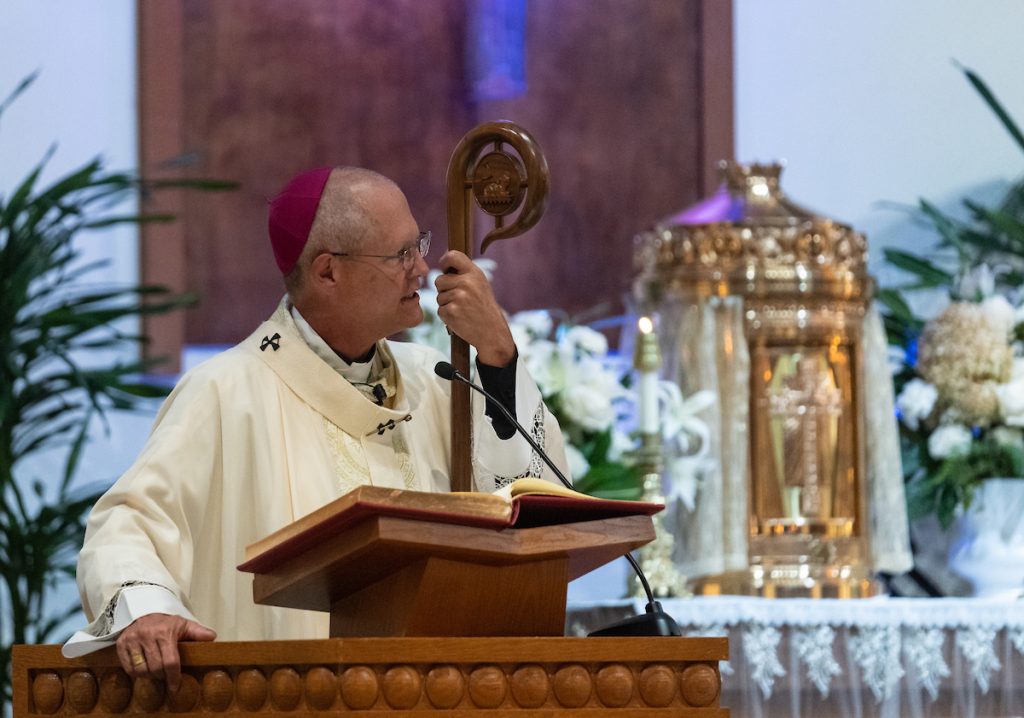
Twenty-fifth anniversary of perpetual adoration at St. Pius X Catholic Church, on Wednesday, September 8, 2021 in Montlake Terrace, Washington. (Photo by Stephen Brashear)
During this pastoral planning process, in the Archdiocese of Seattle, as we spend time renewing our relationship with Jesus Christ, a starting point is to ask just how is this done?
Pope Benedict XVI wrote about the nature of the Church in his Encyclical, God Is Love.
The Church’s deepest nature is expressed in her three-fold responsibility: of proclaiming the word of God (kerygma-martyria), celebrating the sacraments (leitourgia), and exercising the ministry of charity (diakonia). These duties presuppose each other and are inseparable. (Deus Caritas Est, #25)
It makes sense that to renew our relationship with the Christ, we would look to the nature of the Church, which is the body of Christ.
A simple tour of any Catholic church will tell us about the privileged means of the all-important moment of the personal relationship with Jesus Christ. First, let’s visit the baptismal font. Here in these life-giving waters, we die to self and rise again in the life of the Risen Christ. In baptism, we begin our life in Christ and enjoying his life in our own. Then look for the reconciliation room, where in the Sacrament of Reconciliation we receive the mercy of God, all made possible through the death and resurrection of Jesus who reconciled the world to himself.
From here we can go to the sanctuary of the Church where we find both the ambo, or lectern, where God’s living Word is proclaimed. As the psalmist tells us, the Word of God is a lamp for our feet and a light for our path in life. (Psalm 119:105) St. Paul invites us to allow the Word of God to live deeply within us. (Colossians 3:16) As God spoke to Moses and the Prophets in the Old Testament, he speaks to us through his Son Jesus today, and Jesus is the Word of God made flesh. (John 1:14) Thus, the Word when it is proclaimed at Mass each day is a living voice of God still speaking in our time.
In the center of the sanctuary, we find the altar, where the Eucharist is celebrated. Jesus is himself the Bread of life come down from heaven. (John 6:35)
The bread and wine we offer to God is given back to us, to be our heavenly food, the very Body and Blood of Christ. The sacrifice of Christ, offered once for all on the cross, is renewed in this mystery, and through our Eucharistic sharing, we participate in that same sacrifice. Christ’s presence in this sacrament is not merely a symbolic representation of our unity as a community, or a reminder of his love. In the Eucharist, the dying and rising of Christ become tangible, and Christ is truly present in our midst: body, blood, soul, and divinity. We call this presence the “Real Presence.” When we receive Holy Communion, we truly partake of the Body and Blood of the Lord, offered for our salvation. We are united with Christ, and through our sharing in this mystery, with each other. (The Work of Redemption)
Finally, the work of charity is central to the nature of the Church, and thus another essential means of encountering Christ. However, we perform the works of charity because this is what Christ has instructed us to do. (Matthew 25: 31-46) In generously serving others, in making a gift of ourself in the model of Christ’s life and ministry, his death and resurrection, we freely give what we have first received from the Lord. (See Matthew 10: 1-8)
In addition to these privileged means of encountering Christ which are expressive of the nature of the Church, Word, Sacrament and Eucharist I always add the fourth category, which recognizes the freedom of Christ, who always takes the initiative, to act in any way he chooses in any of our lives.
Let us continue to seek Christ, to grow in relationship with Christ, that we may live our faith in him with even greater unity, truth, and love.
0